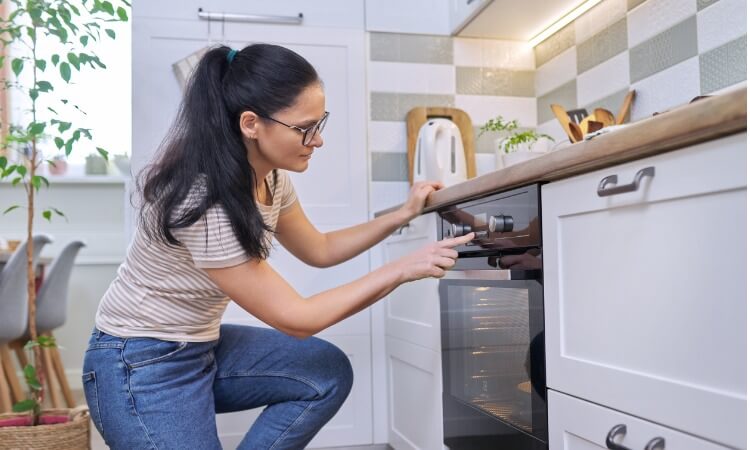
You know the term ‘easy as a pie’ can be a little bit inaccurate. Flaky, smooth pie crust can be tougher to bake, that’s why most bakers blind bake their pie crust. Blind baking is a process used before filling a pie crust. Pie crust is fragile, and baking it without proper blind baking process will result in breakage and shrinking. But you can get your pie crust perfect with a bit of love and careful temperature control. In this article, I’m going to give you some tips on what temperature to bake a single pie crust.
What Temperature to Bake a Single Pie Crust
To discuss what temperature to bake a single pie crust, I’ve made a simple step by step tutorial on how to bake a pie crust.
Ingredients
- 1 ¼ cups of flour
- 1/8 tsp of salt
- ¼ cup of coconut oil
- 2 to 4 tbs of water
Directions:
- You need to pre-heat the oven to 425 degrees Fahrenheit.
- Mix salt with flour.
- Apply coconut oil and whisk the flour with a fork before tiny pea-size crumbles.
- Swirl the flour mixture with a fork and add water a little at a time.
- Stir until moistened, and shape a dough disk.
- Form your hands into a sphere.
- You can opt to use a rolling pin to the pie crust flour.
- Fold it in between two sheets of parchment paper. It will quickly come off the paper, and the dough does not adhere to the rolling pin.
- Take the dough disk, and place it in the center of the oiled parchment.
- Smooth the dough into a dense, flat, circular form.
- Now place the oiled parchment on top of the flattened pastry.
- Roll the pie plate into a shape 2 inches narrower than the diameter.
- Remove the top piece of parchment and invert the crust.
- Arrange the dough in the pie pan such that an equal volume of dough falls uniformly all over the pie plate. It is best to line it up before placing it on the pie plate.
- Flake the side and add a pie weight on the bottom of the crust to keep the crust from bubbling up when baking.
- Bake 10 minutes, at 425 degrees Fahrenheit.
- Bake another 25 minutes or until softly golden, but lower your oven temperature to 350 degrees Fahrenheit.
How to Control the Temperature to Bake A Single Pie Crust
In this section, I’m going to give you some useful tips that you can apply to how and at what temperature to bake a single pie crust.
Use Parchment Paper
You can layout the crusts using parchment paper. To handle fragile pie dough, I strongly suggest this easy technique. Roll the surface between two bits of oiled parchment. Rub off the top sheet of paper and the bottom part of the parchment before inverting the pie crust to your side. Place the crust across the diameter of your pie plate into the middle for an even line of crust. Trim the baking parchment, which should be now on top of the pie. Be sure first to remove the edges, so it doesn’t break. Arrange the pie crust within the plate and flute the edges if you wish. Then, it’s headed to the oven.
The only trick to bake your crust without a filling is that during baking, the bottom of the crust can bubble up. That is not wishful thought. If the crust is twisted, the pie quality will suffer. To prevent this issue, place a sheet of tinfoil on top of the pie crust. Place something to withstand the oven temperature and to weigh it down. You can use the pinto beans to weigh down your pie crust.
Dock the Pie Crust
Since the bottom of the pie crust is filled with weights, it doesn’t cook. Here is a quick fix. When the crust has browned around the edges, cut the parchment paper and the weights cautiously, then let the crust cook on its own for a little longer. Keep in mind that the crust’s bottom layer may start puffing up, so use a fork to poke holes through it. It will create steam to escape and prevents a lot of puffing. Nicking in pie crust holes is also known as ‘docking’ pie crust.
Some bakers and individuals only dock the pie crust, rather than use pie weights. My pie crust also shrinks from its edges. So I use pie weights all the time, cut them after the edges turn white, dock the crust with a fork, and return it to the oven so the bottom will be cooked. The oven temperature period depends on whether you like a partial blind baked or a fully blind-baked pie crust.
Why Pie Crust Is Tough and Hard
The unbalance texture of the crust will destroy a beautiful pie. The consequence of so much gluten production is hard, unyielding crusts, while the flaky crust is the product of proper fat distribution. Let’s look at this challenge to see what temperature to bake a single pie crust.
Gluten is a natural result of combining two wheat proteins in the presence of water (glutenin and gliadin). When we knead bread dough, we bring about a good development of gluten, that will give us chewy, well-structured bread that is tough to work like a dough. Yet the stretchiness will turn into a rough pie crust. Noone likes their pie crust chewed.
To fix this problem, we can do four things:
- Decrease the gluten in the flour
- Decrease the kneading
- Decrease the water
- Decrease the temperature
The first way to having the pie crust perfect is by using a lower-gluten recipe. Bread meal has a high content of gluten, whereas cake has the lowest content. It is better to give the pie an all-purpose or pastry flour because they strike a compromise between the simplicity of usage and tenderness.
Conclusion
Choose the right tools and keep an eye on the temperatures. Remember: The secret to a successful single pie crust baking is thermal control. Once you know what temperature to bake a single pie crust, keep doing it. You can get a flaky and tender crust by keeping your pie smooth and delicate finish without overcooking your pie. Get more tips on baking pies.
